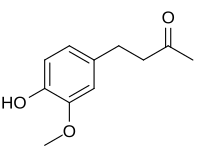Zingerone facts for kids
Zingerone, also known as vanillylacetone, is a special chemical that gives cooked ginger its sweet taste. It's a solid, like tiny crystals. Zingerone doesn't dissolve much in water, but it mixes well with a liquid called ether.
This chemical is similar to other flavor compounds like vanillin (which gives vanilla its smell) and eugenol (found in cloves). Zingerone is used to add spicy smells and flavors to things like spice oils and perfumes.
Interestingly, fresh ginger doesn't have zingerone. It only forms when ginger root is cooked or dried. This happens through a chemical change involving another compound in ginger called gingerol.
Quick facts for kids Zingerone |
|
|---|---|
 |
|
|
Preferred IUPAC name
4-(4-Hydroxy-3-methoxyphenyl)butan-2-one
|
|
| Identifiers | |
| CAS number | |
| PubChem | |
| ChEBI | CHEBI:68657 |
| SMILES | O=C(C)CCc1cc(OC)c(O)cc1 |
|
InChI
InChI=1/C11H14O3/c1-8(12)3-4-9-5-6-10(13)11(7-9)14-2/h5-7,13H,3-4H2,1-2H3
|
|
| Properties | |
| Molecular formula | |
| Molar mass | 0 g mol-1 |
| Melting point | |
| Boiling point | |
| Insoluble | |
| Solubility | Miscible in ether |
| Except where noted otherwise, data are given for materials in their standard state (at 25 °C, 100 kPa) | |
Contents
How Zingerone is Made
Early Discoveries
Zingerone was first found in ginger root in 1917. A chemistry professor named Hiroshi Nomura from Tokyo Imperial University was the one who isolated it.
Nomura gave the compound its name. He also figured out its basic chemical makeup. At first, he thought zingerone was what made ginger spicy. Later studies showed this wasn't quite right.
Modern Ways to Make It
Professor Nomura also found a way to create zingerone in a lab. He even got a patent for his method. This process starts by mixing vanillin and acetone under certain conditions. This reaction creates a compound called dehydrozingerone, which is almost 95% pure.
After that, a process called catalytic hydrogenation is used. This step changes the dehydrozingerone into zingerone. This final step is very efficient, producing almost 100% pure zingerone.
How Zingerone Affects the Body
Chemicals found in ginger, including zingerone, can help fight certain types of diarrhea. This kind of diarrhea is caused by bacteria like Escherichia coli and is a major cause of infant deaths in some countries. Zingerone is likely the main part of ginger that helps stop this diarrhea.
Zingerone is also known for being good at fighting "free radicals." These are unstable molecules in the body that can cause damage. Zingerone can help clean up these free radicals. It also stops certain enzymes that create these harmful molecules.
Some flowers use zingerone to attract fruit flies. The smell helps the flies find the flowers, which is important for pollination.
See also
 In Spanish: Zingerona para niños
In Spanish: Zingerona para niños
- Ginger
- Vanillin
- Eugenol

